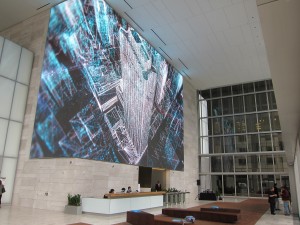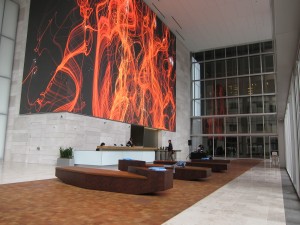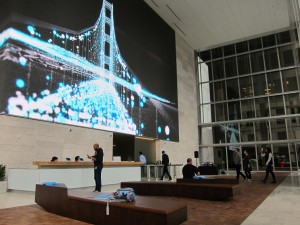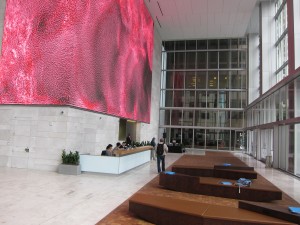
By Sharon Simonson
SAN FRANCISCO—Near midday on Monday, March 14, Marc Benioff, founder and chief executive of San Francisco’s Salesforce.com, paused to look up as he entered his company’s new offices at 350 Mission St.
Wearing his signature dark sports vest, jeans and running shoes with a Salesforce-blue, short-sleeved collared shirt (tucked in), the 6’ 5’’ tech visionary focused on the huge (2,800 square feet) LED screen that dominated the glass-walled, 50-foot lobby.
As he watched, dozens of electric-red spaghetti noodles rose from the bottom of a black screen. After a few moments, they were replaced with a slowly moving blue, aqua and white mosaic.![]()
The images—both abstractions and identifiable city scenes—are part of a first-of-its-kind artwork by Turkish-born media artist Refik Anadol. “Virtual Depictions: San Francisco” explores the relationship between modern existence and the electronic-data exhaust we produce individually and collectively every day. It merges Twitter messages sent in the city and gathered from Twitter servers each morning at 2 a.m. with city of San Francisco municipal data of every conceivable sort.

The resulting images, big and bold, move cloud-like across the screen, telling wordless stories. “It’s a weird virtual reality,” Anadol said. “We are calling them ‘visual sculpture.’”
The 30-year-old, born and raised in Istanbul, is not sure if he’s an artist or technologist first. He earned a master of fine arts in media arts in 2014 from UCLA, where he was now a guest lecturer. Before that, he attended Istanbul Bilgi University on scholarship, earning a bachelor of arts and master of fine arts in visual-communication design.

He was delighted to report that the U.S. government recently granted him legal permanent residency. He hoped to become a U.S. citizen soon. Being an artist in Istanbul felt much more spontaneous than in the United States, less inhibited by municipal process and review. But both Turkey and America are characterized by a huge multiplicity of cultures and peoples living largely harmoniously together, he said.
Upcoming projects were in Boston, Paris and Istanbul. He was also working with the Los Angeles Department of Transportation on “City of Bits / LADOT,” using GPS technology to present images of the real-time travel of every department vehicle. He has worked with figures including Frank Gehry and institutions such as the Los Angeles Philharmonic.
In San Francisco, the artist credited John Kilroy of Kilroy Realty Corp., which owns 350 Mission, with conceiving the idea to have a huge canvas or screen in its lobby. (“He is a very visual person,” Anadol said.) Building architects Skidmore Owings & Merrill proposed the soaring glass walls. The screen is so large, the inside-outside connection so strong, and the images so vibrant that the art can be seen from across the street and down the block.

The installation satisfied the city’s public-art requirement for all large office developments in downtown. “One of the biggest challenges is how can we create a story for 21st century public art,” Anadol said.
He estimates that each LED in “Virtual Depictions” would last 100,000 hours—a little longer than 11 years. “Any digital device has an ultimate operation time. None of them can live forever,” he said. “It doesn’t die; it kind of fades out, like our breath. The videography of the piece will be there forever, but the experience itself has a time span.”
Southern California’s light-and-space art movement of the 1960s and early 1970s inspired him to come to UCLA. The artists “really focused on minimalism, optical arts and abstraction. Very inspiring guys like James Turrell, Bruce Nauman, Robert Irvin and Ron Cooper were making an incredible amount of art using this idea of pure perception.
“I wondered what would happen if the same mindset were upgraded” by modern technological tools, he said.
Salesforce, a software and data storage and delivery company itself, “had an incredible, positive reaction to the art and the technology,” Anadol said. “I had beautiful meetings with them. They were so supportive. ‘Virtual Depictions’ is a perfect fit in San Francisco. It wouldn’t make much sense in Chicago.”![]()